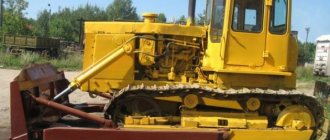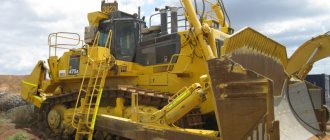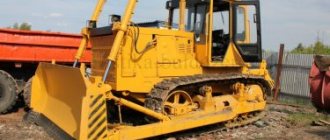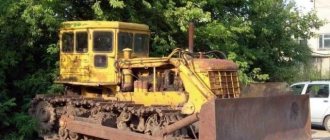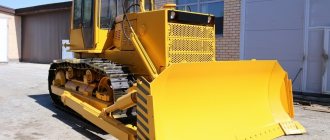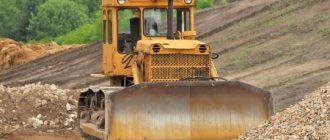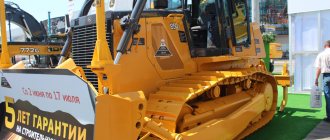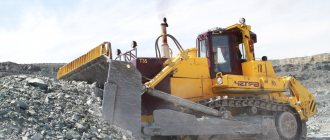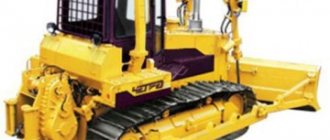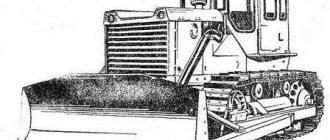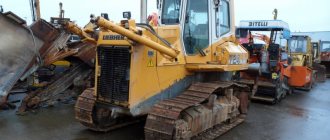The DET-250 tractor is a ripper and bulldozer equipment of the 25th traction class. Production has always been carried out at ChTZ. It was not transferred to other cities. The most important feature of this model is the electromechanical transmission. This is both an advantage and a disadvantage of this technique. The cooling process is carried out by exhaust gases.
Moreover, there are some difficulties associated with lowering the operating temperature. That is why this technique was mainly used and is still used today in cold regions, in the conditions of the Far North. In regions with such a climate, the use of DET-250 is optimal. Previously, similar models to DET-250 were not produced. In fact, he became the founder of industrial tractors in the USSR. Later versions of tractors became continuations of the model line and analogues: DET-320, T-330.
Purpose
In addition to the basic bulldozer blade and ripper, the DET-250 can be combined with:
- pit drill;
- drilling crane machine;
- trench excavator.
The machine is used for bulldozing and ripping work, as well as for the installation of railway supports, industrial construction, mining and development industries. The large dimensions and large weight of the tractor made it unsuitable for working in urban conditions. The high power of the machine and other operational characteristics are used today exclusively on an industrial scale.
Driver reviews
Most owners note the convenience of the hood lift. This allows quick access to all the main systems of the bulldozer, facilitating routine replacement of working fluids.
All machine parts are of high quality and provide a safety margin, which means there is no need to frequently repair the equipment. With timely maintenance, DET-250 operates trouble-free for several years, guaranteeing full efficiency.
When the need arises to repair something, the actions are simple, since the design of most systems is simple. This does not apply to just one component - the transmission. Its breakdown causes many problems. The driver can fix everything else himself, using the detailed instructions included with the bulldozer.
Specifications
At the time of its creation, DET-250 had truly outstanding technical characteristics. The reason was the creators' focus on maximum performance of this model.
Dimensional and mass indicators
The overall dimensions and weight of the DET-250 bulldozer are quite impressive. The reason for this was some design features. Weight is:
- tractor complete with ripper – 41.3 t;
- tractor without ripper – 27.5 t.
A significant part of the operating weight of this equipment is made up of specialized attachments (blade with special hydraulics that change the cutting angle, skew):
- blade tire, mm – 4,250;
- dump height, mm – 1,850;
- weight of attachments, t – 5.2.
Overall dimensions of DET-250:
- distance from the axis of the front roller to the axis of the rear roller, mm – 4,476;
- distance from the axis of the rear roller to the front part of the blade, mm – 6,549;
- distance from the front of the blade to the rear of the attachment, mm – 9,440;
- height from the bottom of the track to the top of the cabin, mm – 3,215 mm;
- width, mm – 5,000.
Engine
The V-31M2 engine was used as the power plant for this vehicle. Its two main distinguishing features are power and overall dimensions. Technical characteristics of V-31M2:
- number of cycles, pcs. - 4;
- type of cylinder arrangement – V-shaped;
- operating power at rated speed, hp – 323;
- operating power at rated speed, kW – 237;
- rated crankshaft rotation speed, min-1 – 1400;
- working volume of the combustion chamber, l – 38.88.
Engine Features:
- cooling system – liquid with ejection ventilation system;
- air cleaner – 2-stage with a clogging indicator and 2 phases of air cleaning (ejection and wet);
- lubrication system – combined with cleaning in a centrifuge.
Characteristics of the V-31M4 engine:
- working volume – 38.88 l;
- rated power – 237(323) kW (hp);
- design rotation speed – 1400 rpm;
- number of cylinders – 12;
- cylinder diameter – 150 mm;
- torque reserve – 11%;
- fuel consumption – 45.3 l/hour;
- Fuel tank capacity – 700 l.
Fuel consumption
Specific fuel consumption is more than 40 l/1 hour at maximum performance. The filling capacity is 700 l.
Transmission
The main feature of this tractor is the transmission. It is electromechanical and has the following main operating parameters:
- total number of speeds, pcs. – 2 (forward/backward);
- magnitude of traction force, max – 377 kN;
- forward speed, km/h – 15.2;
- reverse speed, km/h – 15.2.
Chassis
The chassis simply does not have any special features other than the dimensions of its main components, as well as mass and high ground pressure. Its main characteristics:
- total number of road wheels (on each side), pcs. – 6;
- number of supporting rollers, pcs. – 2;
- shoe width, mm – 560/690 (depending on the type of rollers used);
- automatic tension mechanism – hydraulic type;
- track size, mm – 2,450;
- base size, mm – 3,218.
Area of demand for tractors
Significant dimensions and caterpillar tracks are not designed for use of the tractor on a city scale. The main scope of application is industries that will require equipment with increased engine power characteristics. The tractor is used in the mining, oil and gas industries. The construction of railways, highways, and hydraulic structures cannot be done without it.
The scope of use of DET 250 depends on the attachment. It is attached to the rear of the unit. The bulldozer is operated with earthmoving, drilling, and trenching equipment. With the help of a loosening installation, at the stage of preparatory work, rocky, rocky and frozen soils are loosened. Thanks to the caterpillar drive, the tractor exerts low pressure on the ground and can be used in hard-to-reach places, even swamps.
History of DET 250
Design and operating features
The layout of the DET 250 is standard for vehicles of this type (transmission at the rear, engine at the front). The basis of the body is a powerful sealed welded frame. The elements are fixed to it using various mechanisms. The chassis has no special features other than dimensions and weight. Welded bogies are made in the shape of a rectangular section and are rigidly connected to the main frame. To support the caterpillar track, 12 rollers are used (6 on each side). The number of support rollers is 4 on each side. It consists of 56 links with a pitch of 218 mm. Track tension is adjusted using a hydraulic mechanism.
The bulldozer uses a continuously variable electromechanical transmission operating on direct current. Speed adjustment occurs without gear shifting, taking into account the level of external load. The transmission design includes a permanently closed multi-plate friction type clutch. The transmission itself has a complex design and is the most problematic element. The power transmission includes an EDN 196 traction motor, complex planetary mechanisms, a GPA 222 model generator, a main gear and a final drive. The generator drive contains a helical cylindrical multiplier. The transmission has 2 forward and 2 reverse gears and provides the necessary maneuverability.
For turning, planetary 2-stage mechanical gearboxes are used. The design of the machine includes a reliable floating brake band system.
The hydraulic system consists of 2 axial piston power pumps with a pressure of 10 MPa. There is also an auxiliary hydraulic system, equipped with one pump capable of maintaining similar pressure in the circuits. The main working parts of the bulldozer are a hemispherical blade made of durable metal and single-tooth ripping equipment.
Compared to other Soviet machines, the DET 250 stands out for its high level of operator comfort. All modifications are equipped with an all-metal cabin designed for 2 people. The cabin is mounted on special springs that reduce vibrations that occur during operation of the equipment. The cabin has an autonomous heater, which perfectly warms up the interior even at extremely sub-zero temperatures. For operation in hot weather there is a special fan included in the basic package. The seat has a comfortable design and has several adjustments.
The instrument panel is designed so that the operator can monitor the main parameters of the machine without stress. Indicators and controls are grouped and divided into sectors to simplify operation. The cabin is maximally protected from dust and noise, which is especially important given the specific operation of the DET 250. Optionally, the customer is offered additional insulation of the interior.
Bulldozer maintenance is simplified. The hood type body provides access to key systems. The machine elements have a high safety margin, so the need for repairs occurs quite rarely. With regular maintenance, the equipment functions for several years with maximum efficiency. The main problem of the DET 250 is the unreliable and complex transmission; the operator can repair the rest of the equipment in the field.
Cabin
The tractor was controlled from a metal cabin. It was equipped with insulation and extensive glazing. This is what made it convenient for the driver’s position, as well as control when moving forward and backward. A distinctive feature was the location of the driver's seat - on the right side of the cabin. The control itself was carried out using levers; there was no steering wheel. There is a stove in the cabin. But there is no ventilation.
By today's standards, the cabin was not particularly comfortable. But at the time the tractor itself was created, it was quite convenient. There is a seat for the passenger, and there is also the possibility of adjusting the driver's seat in height. In summer it was possible to open the windows for ventilation.
Engine
The proven V-31M2 diesel engine was chosen as the bulldozer's power plant. Its main distinguishing features are moderate fuel consumption, despite the declared power. The unit's specifications are as follows:
| Parameter | Meaning |
| Number of cycles | 4 |
| Engine cylinder arrangement option | V-shaped |
| Declared operating capacity | 323 hp (237 kW) |
| Optimal number of crankshaft revolutions per minute | 1400 |
| The combustion chamber | 38,88 |
According to reviews, the main feature of the bulldozer is the transmission. This unit is electromechanical. It contains the following data:
| Index | Meaning |
| Number of speeds | front - 2, the same number of reverse gears |
| Traction force | 377 kN |
| Declared travel speed in any direction | up to 15.2 km/h |
Modifications
The DET-250 tractor, due to its functionality and uniqueness, continued to be produced until 2013. But due to the age of development, the model itself is now outdated. A continuation of this line was the DET-320 tractor.
The distinctive features of this model, produced from 2002 to 2007, are the following:
- a liquid cooling system is used, with the radiator located frontally (a fan controlled from the cabin is used for additional cooling);
- the chassis is reinforced with: spars installed on the bogie frame;
- torsion bars with equal rigidity were used;
- updated double glazing installed;
Main characteristics of DET-320:
- YaMZ engine – 7511;
- power, hp – 350;
- draft class – 25;
- maximum operating weight, t – 46.
DET-320
In 2007, the DET-320 tractor was completely discontinued. At the same time, a new model was launched into the series - DET-400. The main design features of this model are the following:
- the reliability of all electric machines, their service life is doubled compared to previous models of similar ChMZ tractors;
- if necessary, the transmission power generator can be used as a diesel generator power plant;
- the control system is contactless - there is no need to make significant efforts to change gears or control movement;
- There is an on-board computer equipped with a liquid crystal display.
The following additionally purchased equipment can be installed on the type of modification in question:
- preheater type PZhD 30E;
- installation of “spur” type lugs is possible;
- special spherical dump for hard coal.
DET-400
In 2012, the DET-400 model was modified. The updated version began to be designated as DET-400M. The most significant updates to this technology were the following:
- all drive wheels, as well as guides, rollers and tracks are used from Caterpillar;
- instead of the domestic YaMZ, Cummins began to be installed - it is assembled in the UK;
- During assembly, a fundamentally new hydraulic system, different from the old model, is installed - controlled using a joystick.
DET-400M
The models of this type are universal, they all have one purpose. They can be used not only as ordinary bulldozers, but also as rippers. It is possible to install additional attachments of the following type:
- hole drill;
- crane installation (used for installation of power line supports);
- trench excavator.
Each modification has its own characteristics, advantages and disadvantages. Before purchasing, you should carefully familiarize yourself with all of them and the specifics of their work.
History of development and purpose of the DET-250 tractor
The tractor was developed and produced by the Chelyabinsk Tractor Plant in 1957.
Refers to heavy power-assisted tractors of the 25th traction class. The need to produce a heavy machine was dictated by the large-scale construction of those years, including highways, power lines and pipeline routes in the taiga and northern climate. A powerful, unpretentious machine was required to work far from civilization.
Tractor DET-250 1957
When developing a tractor, engineers faced a fundamental problem: in special machines with traction classes above 20, when using a mechanical transmission, efficiency decreases, engine operation becomes ineffective, and this disadvantage intensifies with increasing traction class. The world's leading manufacturers of heavy tractors have bypassed the engineering deadlock by using a hydromechanical transmission. Our developers used a different principle - the technology used an electromechanical transmission. The DET-250 tractor and its modifications contain the letter “E” in their name, which denotes a hybrid electric drive system.
The diesel engine rotates a high-voltage power generator, which drives the traction motor. The use of powerful electrical equipment increased the weight of the machine and required an additional cooling system for the generator and electric motor. These problems were successfully solved, and the DET-250 tractor, working in the optimal conditions of the Far North, showed its advantage over analogues with a hydromechanical transmission, which failed in severe frosts.
The main area of application of the DET-250 tractor is the zero construction cycle. It is designed for leveling virgin areas with preliminary loosening of heavy soil (stones, permafrost), as well as for moving masses of soil, crushed stone, sand by pushing, for digging trenches and drilling holes and wells. With an attached crane, it is used to install supports and poles.
When using special attachments, the tractor works like a tractor in logging.
The weight and dimensions of the machine make it impractical to use in urban areas and agriculture.
Operating experience
The main advantages of DET-250 today include the following:
- unpretentiousness to working conditions - the equipment showed excellent performance in working conditions from +40 to -400 C;
- relative ease of repair and availability of spare parts - the tractor has been produced for decades, the market is filled with all the parts necessary for repair;
- unpretentiousness to fuel quality - you just need to use special diesel fuel in winter, otherwise it will thicken and freeze in the fuel line;
- the body is hood type - for this reason, you can easily access all units.
At the same time, DET-250 has its own disadvantages.
The most significant is the complexity of the electromechanical transmission design. It is quite problematic to understand its design without special training. However, all other breakdowns that occur during operation can be easily eliminated yourself - if you have a repair manual. With proper maintenance and care, DET-250, even at the age of several decades, will not cause problems to the owner.
Despite the simplicity of the design, the tractor has a number of weak points - you need to pay attention to them first when working on the DET-250. The most common malfunctions and their methods
| Fault location | Possible reason for its occurrence | Elimination method |
| Hydraulic frame of a bulldozer installation | Installed seals have worn out due to poor quality or age | It is necessary to unscrew the adjusting nut and tighten all the bolts of the scraper located on the bulldozer |
| Ripper hydraulic cylinder | The service life of the sealing gaskets is completely exhausted | Unscrew the adjusting washer and tighten the adjusting bolts |
| The ripper blade/tooth does not sink into the ground well | Worn: Working edge of knives | Replace knives |
| Worn tip | Replace the tip | |
| The cutting angle when working with a blade does not correspond to the selected one | Select the required angle |
Owners who have been operating the tractor in question for a long time recommend that every 10 thousand operating hours carry out a control check of the following components:
- level: working fluids;
- fuels and lubricants;
The electromechanical transmission deserves special attention. It is imperative to constantly monitor contact connections and terminal blocks. Since with oxidation and deterioration of contact, not only breakdown, but also fire is possible. It is quite difficult to extinguish burning insulation. Therefore, it is important to prevent overheating of the contact connections.
Cabin
The bulldozer is controlled by a driver, for whom a cabin is equipped. The metal frame with panoramic glazing is provided with a heating system. The room is convenient for work; people can easily move equipment around. A distinctive feature is the right-hand position of the chair.
They control the equipment using levers, since there is no steering wheel. There is no built-in ventilation, so there is no particular comfort. Although at the time of release, even the presence of heating was considered a convenience. There is a passenger seat, the driver's seat is comfortable, it is easily adjustable in height. In hot weather, you have to open the windows for ventilation.
The cabin is mounted on soft springs, which almost completely dampen vibrations caused by the operation of the equipment. The autonomous heating system perfectly warms up the interior, despite extreme frosts. In the basic configuration, the cabin is equipped with a fan that blows air over the driver.
The instrument panel is equipped so that the driver can freely monitor any parameters of the equipment’s operation. The controls, along with status indicators, are grouped into sectors to make them easier to control. The cabin is as sealed as possible, which is important considering the specifics of the bulldozer’s operation.
Service
Thanks to the hood-type body, access to the main tractor systems did not cause any difficulties. All parts were of very high quality and had a large margin of safety, so there was no need for frequent repairs. With proper maintenance, the equipment could work reliably for several years with full efficiency. And in the event of a breakdown, repair was not particularly difficult, since the structure of the device was quite simple.
The only problem that could cause difficulties was a transmission breakdown. It was too sophisticated. All other equipment could be repaired by any mechanic using the equipment's operating instructions. Spare parts for DET-250 could be purchased without any problems from an official dealer.
Advantages and disadvantages
Bulldozers of the DET series have the following advantages:
- possibility of operation at temperatures down to -40°C;
- no problems with spare parts;
- easy access to components for maintenance;
- possibility of working in swamps after installing wide tracks.
Disadvantages of bulldozers:
- repair of electromechanical transmission components is possible in specialized workshops;
- the use of double energy conversion increased the weight of the tractor.
Price
An important advantage of the DET-250 is that it is possible to purchase a unit in fully working condition at a low cost. The price of special equipment is directly affected by its condition, location and number of years of operation. An inflated amount is requested where industrial construction is concentrated and various minerals are mined.
For example, it is worth mentioning that in Chelyabinsk a bulldozer produced in 2007 is sold at a price of 6.6 million rubles. with a spherical blade. In a similar condition, a DET-250 from 2009 in Kazan costs 9.2 million rubles, and in Krasnoyarsk they demand only 3.1 million for a 2008 unit.
Video: bulldozer DET-250.
